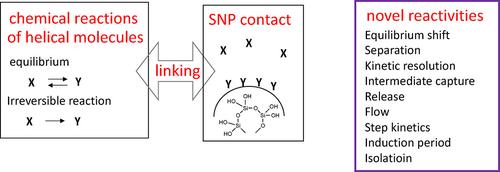当前位置:
X-MOL 学术
›
Chin. J. Chem.
›
论文详情
Our official English website, www.x-mol.net, welcomes your feedback! (Note: you will need to create a separate account there.)
Linking of Chemical Reactions and Silica Nanoparticle Contact Using Synthetic Helical Molecules
Chinese Journal of Chemistry ( IF 5.4 ) Pub Date : 2024-04-22 , DOI: 10.1002/cjoc.202300748 Sheng Zhang 1 , Ming Bao 1 , Mieko Arisawa 2 , Masahiko Yamaguchi 1
Chinese Journal of Chemistry ( IF 5.4 ) Pub Date : 2024-04-22 , DOI: 10.1002/cjoc.202300748 Sheng Zhang 1 , Ming Bao 1 , Mieko Arisawa 2 , Masahiko Yamaguchi 1
Affiliation

|
Comprehensive SummaryBiological cells exhibit diverse phenomena induced through linking of chemical reactions of molecules and solid surface contact. It is then a significant topic in the field of chemistry to study phenomena induced through this linking using synthetic systems, which can promote our understanding of biological phenomena and can be applied to the development of novel functions. Silica nanoparticles (SNPs), which are synthetic inorganic materials, are attractive for such purposes, because of their following characteristics: they can adsorb large amounts of molecules on their surfaces, they can aggregate through contact between SNPs as well as contact between molecules and SNPs, and the molecules can be easily removed from solutions by precipitation. The contact of SNP surfaces with molecules then affects chemical reactions of molecules and also behaviors of SNPs. This article describes systems derived from synthetic helical molecules and SNPs, which exhibit notable phenomena including selective adsorption and molecular recognition, equilibrium shift, step kinetics with induction period, precipitation with flow and sweeping, and disaggregation and desorption by sonication, in which the high affinity of helical molecules with SNP surfaces plays important roles. Mechanistic models that explain the phenomena are provided. Possible applications are also discussed, including the separation of molecules, capture of intermediates, the storage and release of molecules, equilibrium shift, clocking, and the translation of mechanical stimulations into chemical reactions.
中文翻译:

使用合成螺旋分子连接化学反应和二氧化硅纳米粒子接触
综合总结生物细胞表现出通过分子化学反应和固体表面接触的联系而引起的多种现象。因此,使用合成系统研究通过这种连接引起的现象是化学领域的一个重要课题,这可以促进我们对生物现象的理解并可应用于新功能的开发。二氧化硅纳米粒子 (SNP) 是一种合成无机材料,在此类用途中具有吸引力,因为它们具有以下特性:它们可以在其表面吸附大量分子,它们可以通过 SNP 之间的接触以及分子与 SNP 之间的接触而聚集,并且分子可以通过沉淀轻松地从溶液中去除。 SNP 表面与分子的接触会影响分子的化学反应以及 SNP 的行为。本文描述了源自合成螺旋分子和 SNP 的系统,这些系统表现出显着的现象,包括选择性吸附和分子识别、平衡位移、诱导期的阶跃动力学、流动和扫掠沉淀以及超声处理解聚和解吸,其中高亲和力具有 SNP 表面的螺旋分子发挥着重要作用。提供了解释这些现象的机制模型。还讨论了可能的应用,包括分子的分离、中间体的捕获、分子的存储和释放、平衡转移、计时以及机械刺激到化学反应的转化。关键科学家
更新日期:2024-04-22
中文翻译:

使用合成螺旋分子连接化学反应和二氧化硅纳米粒子接触
综合总结生物细胞表现出通过分子化学反应和固体表面接触的联系而引起的多种现象。因此,使用合成系统研究通过这种连接引起的现象是化学领域的一个重要课题,这可以促进我们对生物现象的理解并可应用于新功能的开发。二氧化硅纳米粒子 (SNP) 是一种合成无机材料,在此类用途中具有吸引力,因为它们具有以下特性:它们可以在其表面吸附大量分子,它们可以通过 SNP 之间的接触以及分子与 SNP 之间的接触而聚集,并且分子可以通过沉淀轻松地从溶液中去除。 SNP 表面与分子的接触会影响分子的化学反应以及 SNP 的行为。本文描述了源自合成螺旋分子和 SNP 的系统,这些系统表现出显着的现象,包括选择性吸附和分子识别、平衡位移、诱导期的阶跃动力学、流动和扫掠沉淀以及超声处理解聚和解吸,其中高亲和力具有 SNP 表面的螺旋分子发挥着重要作用。提供了解释这些现象的机制模型。还讨论了可能的应用,包括分子的分离、中间体的捕获、分子的存储和释放、平衡转移、计时以及机械刺激到化学反应的转化。



























 京公网安备 11010802027423号
京公网安备 11010802027423号